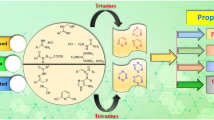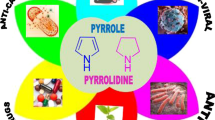Summary
In vitro cytotoxicity and xanthine oxidase inhibition capabilities were investigated for five palladium (II) chelate complexes. The palladium complexes were synthesized by starting from S-alkyl-thiosemicarbazones where the alkyl component is methyl, ethyl, propyl or butyl. The solid complexes are characterized by elemental analysis and spectroscopic techniques (UV-visible, IR and 1H NMR). In order to be able to verify the N2O2-type thiosemicarbazidato ligand (L2−) structure in the square planar geometry, complex 1 has been studied as a representative by using single crystal X-ray crystallography. The in vitro cytotoxic activity measurements were carried out in HepG2 and Hep3B hepatocellular carcinomas, HCT116 colorectal carcinoma, and 3 T3 mouse fibroblast cell lines. The palladium complexes exhibited notable cytotoxic activities in all cell lines at lower μM concentrations compared to the standard chemicals, cisplatin and allopurinol. IC50 values were determined between 0.42 ± 0.01 and 12.01 ± 0.37 μg/ml in examining the antixanthine oxidase abilities of the complexes. Two complexes with S-methyl group exhibited a high inhibition activity on the xanthine oxidase. The results indicated that these complexes could be used as active pharmaceutical ingredients.





Similar content being viewed by others
References
Bankston D, Fang F, Huie E, Xie S (1999) Palladium (II) acetate− Tris (triphenylphosphine) rhodium (I) chloride: a novel catalytic couple for the intramolecular heck reaction. J Organ Chem 64:3461–3466
Soh C, Kamilah S, Shamsuddin M (2012) Tetradentate N2O2 chelated palladium (II) complexes: synthesis, characterization, and catalytic activity towards Mizoroki-Heck reaction of aryl bromides. J Chem 2013:1–8
Gogoi A, Dewan A, Borah G, Bora U (2015) A palladium salen complex: an efficient catalyst for the Sonogashira reaction at room temperature. New J Chem 39:3341–3344
Yaman P, Subasi E, Temel H, Öter O, Celik E (2014) Synthesis, characterization, catalytic applications and optical sensing properties of palladium complexes containing tetradentate schiff bases. Asian J Chem 26
Ali MA, Mirza AH, Butcher RJ, Crouse KA (2006) The preparation, characterization and biological activity of palladium (II) and platinum (II) complexes of tridentate NNS ligands derived from S-methyl-and S-benzyldithiocarbazates and the X-ray crystal structure of the [Pd (mpasme) Cl] complex. Transit Met Chem 31:79–87
Khan SA, Yusuf M (2009) Synthesis, spectral studies and in vitro antibacterial activity of steroidal thiosemicarbazone and their palladium (Pd (II)) complexes. Eur J Med Chem 44:2270–2274
Padhye S, Afrasiabi Z, Sinn E, Fok J, Mehta K, Rath N (2005) Antitumor metallothiosemicarbazonates: structure and antitumor activity of palladium complex of phenanthrenequinone thiosemicarbazone. Inorg Chem 44:1154–1156
Garoufis A, Hadjikakou S, Hadjiliadis N (2009) Palladium coordination compounds as anti-viral, anti-fungal, anti-microbial and anti-tumor agents. Coord Chem Rev 253:1384–1397
Genova P, Varadinova T, Matesanz AI, Marinova D, Souza P (2004) Toxic effects of bis (thiosemicarbazone) compounds and its palladium (II) complexes on herpes simplex virus growth. Toxicol Appl Pharmacol 197:107–112
Afrasiabi Z, Sinn E, Chen J, Ma Y, Rheingold AL, Zakharov LN, Rath N, Padhye S (2004) Appended 1, 2-naphthoquinones as anticancer agents 1: synthesis, structural, spectral and antitumor activities of ortho-naphthaquinone thiosemicarbazone and its transition metal complexes. Inorg Chim Acta 357:271–278
Ferraz KS, Ferandes L, Carrilho D, Pinto MC, de Fátima Leite M, EM S–F, Speziali NL, Mendes IC, Beraldo H (2009) 2-Benzoylpyridine-N (4)-tolyl thiosemicarbazones and their palladium (II) complexes: cytotoxicity against leukemia cells. Bioorg Med Chem 17:7138–7144
Caires AC (2007) Recent advances involving palladium (II) complexes for the cancer therapy. Anti-Cancer Curr Med Chem 7:484–491
Otero L, Vieites M, Boiani L, Denicola A, Rigol C, Opazo L, Olea-Azar C, Maya JD, Morello A, Krauth-Siegel RL (2006) Novel antitrypanosomal agents based on palladium nitrofurylthiosemicarbazone complexes: DNA and redox metabolism as potential therapeutic targets. J Med Chem 49:3322–3331
Kalaivani P, Prabhakaran R, Dallemer F, Poornima P, Vaishnavi E, Ramachandran E, Padma VV, Renganathan R, Natarajan K (2012) DNA, protein binding, cytotoxicity, cellular uptake and antibacterial activities of new palladium (II) complexes of thiosemicarbazone ligands: effects of substitution on biological activity. Metallomics 4:101–113
Vieites M, Smircich P, Parajón-Costa B, Rodríguez J, Galaz V, Olea-Azar C, Otero L, Aguirre G, Cerecetto H, González M (2008) Potent in vitro anti-Trypanosoma cruzi activity of pyridine-2-thiol N-oxide metal complexes having an inhibitory effect on parasite-specific fumarate reductase. JBIC J Biol Inorg Chem 13:723–735
Tetteh S, Dodoo DK, Appiah-Opong R, Tuffour I (2014) Cytotoxicity, antioxidant and glutathione S-transferase inhibitory activity of palladium (II) chloride complexes bearing nucleobase ligands. Transit Met Chem 39:667–674
Alyar S, Adem Ş (2014) Synthesis, characterization, antimicrobial activity and carbonic anhydrase enzyme inhibitor effects of salicilaldehyde-N-methyl p-toluenesulfonylhydrazone and its Palladium (II), Cobalt (II) complexes. Spectrochim Acta A Mol Biomol Spectrosc 131:294–302
Barra CV, Rocha FV, Morel L, Gautier A, Garrido SS, Mauro AE, Frem RC, Netto AV (2016) DNA binding, topoisomerase inhibition and cytotoxicity of palladium (II) complexes with 1, 10-phenanthroline and thioureas. Inorg Chim Acta 446:54–60
Odenike OM, Larson RA, Gajria D, Dolan ME, Delaney SM, Karrison TG, Ratain MJ, Stock W (2008) Phase I study of the ribonucleotide reductase inhibitor 3-aminopyridine-2-carboxaldehyde-thiosemicarbazone (3-AP) in combination with high dose cytarabine in patients with advanced myeloid leukemia. Investig New Drugs 26:233–239
Gojo I, Tidwell ML, Greer J, Takebe N, Seiter K, Pochron MF, Johnson B, Sznol M, Karp JE (2007) Phase I and pharmacokinetic study of Triapine®, a potent ribonucleotide reductase inhibitor, in adults with advanced hematologic malignancies. Leuk Res 31:1165–1173
Battelli MG, Polito L, Bortolotti M, Bolognesi A (2016) Xanthine oxidoreductase in cancer: more than a differentiation marker. Cancer Med 5:546–557
Kalcio MT, Lu M, Kizilay A, Yilmaz HR, Efkan U, Güleç M, Özturan O, Akyol Ö (2004) Adenosine deaminase, xanthine oxidase, superoxide dismutase, glutathione peroxidase activities and malondialdehyde levels in the serum of patients with head and neck carcinoma. Kulak Burun Bogaz Ihtisas Dergisi 12:16–22
Fini MA, Orchard-Webb D, Kosmider B, Amon JD, Kelland R, Shibao G, Wright RM (2008) Migratory activity of human breast cancer cells is modulated by differential expression of xanthine oxidoreductase. J Cell Biochem 105:1008–1026
Sathisha KR, Gopal S, Rangappa KS (2016) Antihyperuricemic effects of thiadiazolopyrimidin-5-one analogues in oxonate treated rats. Eur J Pharmacol 776:99–105
Onul N, Ertik O, Mermer N, Yanardag R (2018) Synthesis and antioxidant, antixanthine oxidase, and antielastase activities of novel N, S-substituted polyhalogenated nitrobutadiene derivatives. J Biochem Mol Toxicol 32:e22021
Coskun MD, Ari F, Oral AY, Sarimahmut M, Kutlu HM, Yilmaz VT, Ulukaya E (2013) Promising anti-growth effects of palladium (II) saccharinate complex of terpyridine by inducing apoptosis on transformed fibroblasts in vitro. Bioorg Med Chem 21:4698–4705
Kapdi AR, Fairlamb IJ (2014) Anti-cancer palladium complexes: a focus on PdX 2 L 2, palladacycles and related complexes. Chem Soc Rev 43:4751–4777
Sheldrick G (2012) SADABS-2012/1:Bruker/Siemens area detector absorption correction program. Bruker AXS Inc, Madison
Sheldrick GM (2008) A short history of SHELX. Acta Crystallogr A: Found Crystallogr 64:112–122
Sheldrick GM (2015) SHELXT–Integrated space-group and crystal-structure determination. Acta Crystallogr. C 71:3–8
Yamazaki C (1975) The structure of isothiosemicarbazones. Can J Chem 53:610–615
Mosmann T (1983) Rapid colorimetric assay for cellular growth and survival: application to proliferation and cytotoxicity assays. J Immunol Methods 65:55–63
Abdullahi A, Hamzah RU, Jigam AA, Yahya A, Kabiru AY, Muhammad H, Sakpe S, Adefolalu FS, Isah MC, Kolo MZ (2012) Inhibitory activity of xanthine oxidase by fractions Crateva adansonii. J Acute Dis 1:126–129
Lineweaver H, Burk D (1934) The determination of enzyme dissociation constants. J Am Chem Soc 56:658–666
Quenelle DC, Keith KA, Kern ER (2006) In vitro and in vivo evaluation of isatin-β-thiosemicarbazone and marboran against vaccinia and cowpox virus infections. Antivir Res 71:24–30
Cukurovali A, Yilmaz I, Gur S, Kazaz C (2006) Synthesis, antibacterial and antifungal activity of some new thiazolylhydrazone derivatives containing 3-substituted cyclobutane ring. Eur J Med Chem 41:201–207
Altun A, Kumru M, Dimoglo A (2001) Study of electronic and structural features of thiosemicarbazone and thiosemicarbazide derivatives demonstrating anti-HSV-1 activity. J Mol Struct THEOCHEM 535:235–246
Saryan LA, Ankel E, Krishnamurti C, Petering DH, Elford H (1979) Comparative cytotoxic and biochemical effects of ligands and metal complexes of .Alpha.-N-heterocyclic carboxaldehyde thiosemicarbazones. J Med Chem 22:1218–1221
Rodrı́guez-Argüelles MC, López-Silva EC, Js Sanmartı́n, Bacchi A, Pelizzi C, Zani F (2004) Cobalt and nickel complexes of versatile imidazole- and pyrrole-2-carbaldehyde thiosemicarbazones. Synthesis, characterisation and antimicrobial activity. Inorg Chim Acta 357:2543–2552
Rodríguez-Argüelles MC, López-Silva EC, Sanmartín J, Pelagatti P, Zani F (2005) Copper complexes of imidazole-2-, pyrrole-2- and indol-3-carbaldehyde thiosemicarbazones: inhibitory activity against fungi and bacteria. J Inorg Biochem 99:2231–2239
Knowles BB, Howe CC, Aden DP (1980) Human hepatocellular carcinoma cell lines secrete the major plasma proteins and hepatitis B surface antigen. Science (New York, NY) 209:497–499
Knasmuller S, Parzefall W, Sanyal R, Ecker S, Schwab C, Uhl M, Mersch-Sundermann V, Williamson G, Hietsch G, Langer T, Darroudi F, Natarajan AT (1998) Use of metabolically competent human hepatoma cells for the detection of mutagens and antimutagens. Mutat Res 402:185–202
Qiu GH, Xie X, Xu F, Shi X, Wang Y, Deng L (2015) Distinctive pharmacological differences between liver cancer cell lines HepG2 and Hep3B. Cytotechnology 67:1–12
Mohsen M (2001) Antioxidants and cognitive function. Nutr Rev 59:S75–S82
Wang Y, Zhu JX, Kong LD, Yang C, Cheng CH, Zhang X (2004) Administration of procyanidins from grape seeds reduces serum uric acid levels and decreases hepatic xanthine dehydrogenase/oxidase activities in oxonate-treated mice. Basic Clin Pharmacol Toxicol 94:232–237
Song JU, Jang JW, Kim TH, Park H, Park WS, Jung S-H, Kim GT (2016) Structure-based design and biological evaluation of novel 2-(indol-2-yl) thiazole derivatives as xanthine oxidase inhibitors. Bioorg Med Chem Lett 26:950–954
Acknowledgements
Supplementary Material Crystallographic data for the structural analysis have been deposited with the Cambridge Crystallographic Data Centre, CCDC No. CCDC 1411477 for complex 1.
We thankful to Ekin Altepe for proofreading.
Funding
This study was funded by The Scientific Research Projects Coordination Unit of Istanbul University, Project Number 54237.
Author information
Authors and Affiliations
Corresponding author
Ethics declarations
Conflict of interest
All authors declare no conflicts of interest.
Ethical approval
This article does not contain any studies with human participants or animals performed by any of the authors.
Additional information
Publisher’s note
Springer Nature remains neutral with regard to jurisdictional claims in published maps and institutional affiliations.
Rights and permissions
About this article
Cite this article
Özerkan, D., Ertik, O., Kaya, B. et al. Novel palladium (II) complexes with tetradentate thiosemicarbazones. Synthesis, characterization, in vitro cytotoxicity and xanthine oxidase inhibition. Invest New Drugs 37, 1187–1197 (2019). https://doi.org/10.1007/s10637-019-00751-1
Received:
Accepted:
Published:
Issue Date:
DOI: https://doi.org/10.1007/s10637-019-00751-1




